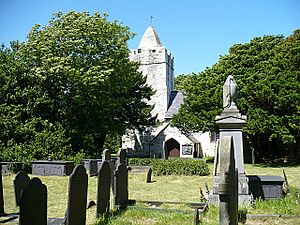St Mechell's Church, Llanfechell facts for kids
Quick facts for kids St Mechell's Church |
|
|---|---|
 |
|
| Country | Wales, United Kingdom |
| Denomination | Church in Wales |
| Architecture | |
| Heritage designation | Grade II* |
| Designated | 5 December 1970 |
| Architectural type | Church |
| Style | Medieval |
St Mechell's Church is a very old church located in the small village of Llanfechell on the island of Anglesey, in Wales. This special building was first built way back in the 1100s! Over the years, it has been repaired and updated, especially in the 1800s and again in the 1990s. Because of its history and unique design, it was officially named a Grade II*-listed building on December 5, 1970. This means it's a very important historical building that needs to be protected.
Contents
Exploring St Mechell's Church
St Mechell's Church is named after a saint called Mechell. It stands in a quiet, countryside area of Anglesey, right in the middle of Llanfechell village. The church was first written about in a record called the Norwich Taxation in 1254. This shows how long it has been an important part of the community.
How Old Is the Church?
The oldest parts of the church are the main hall, called the nave, and the back part where the altar is, called the chancel. Both of these sections were built in the 1100s. The chancel might have been made longer in the 1200s, but it's also possible it was just built very long from the start in the 1100s.
Adding New Parts Over Time
Later, in the 1300s, a side wing called the south transept was added. Another side wing, the north transept, was also added, but we don't know exactly when. It has been updated more recently.
The church also has a tall tower at the western end, which was built in the 1500s. A pointed top, called a spire, was added to the tower in the 1700s. Even the entrance area, called the porch, is probably from medieval times, even though it has been updated.
Changes and Updates
Some experts think that the very first church in the 1100s might have had a tower in the middle, not just at the end. They noticed some unusual shapes and connections in the walls near the center of the church that suggest this.
The church has been repaired and improved many times over the years. Big renovation projects happened in 1840, 1870, and again in the late 1990s. These updates help keep the old building strong and safe for people to use today. Its special status as a Grade II*-listed building, given on December 5, 1970, helps make sure it will be looked after for many more years.

